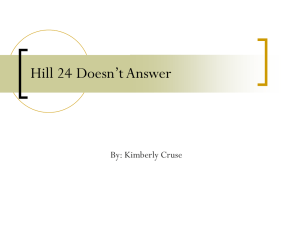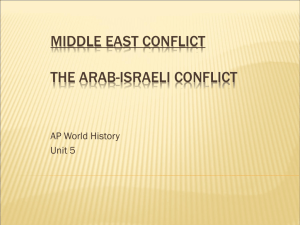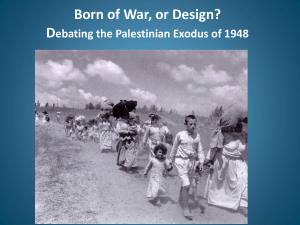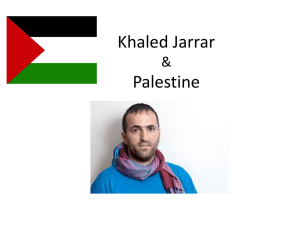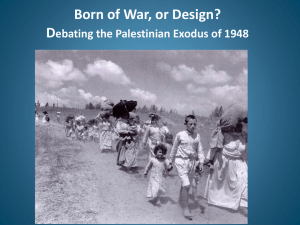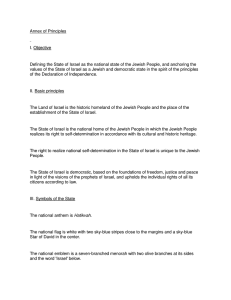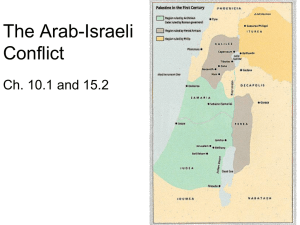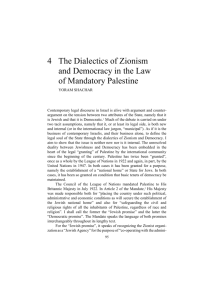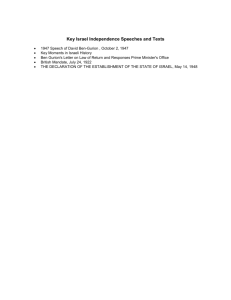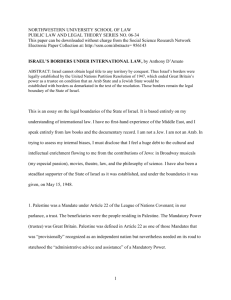The Israeli-Palestinian conflict: Historical Review
advertisement
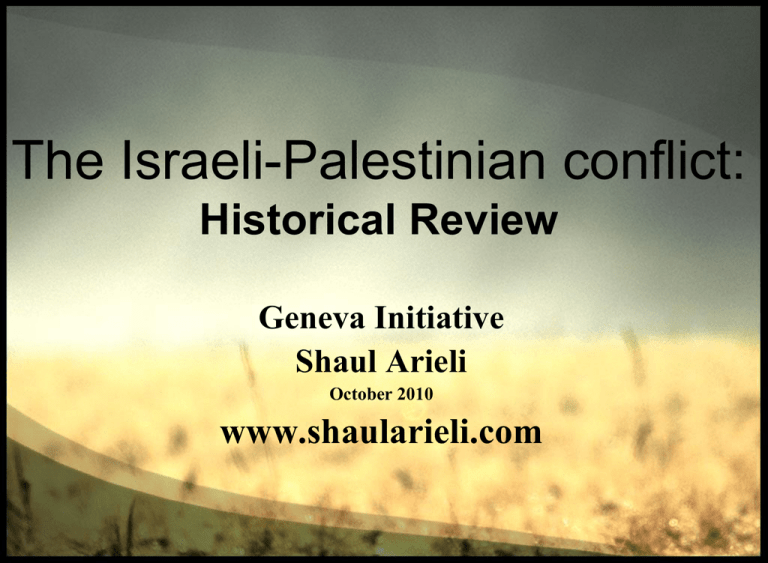
The Israeli-Palestinian conflict: Historical Review Geneva Initiative Shaul Arieli October 2010 www.shaularieli.com 1922-1967 •Mandate •1948 War •Establishment of Israel •Nakba The Jewish State – Resolutions and Actions “The principle of self determination was not applied on Palestine when the mandate was created in 1922 due to the aspiration to enable the establishment of the Jewish national home”. The mandate for Palestine, 1922 (The 1947 partition committee report) “…placing the country under such political, administrative and economic conditions as will secure the establishment of the Jewish national home…” (The mandate for Palestine, 1922) 673,400 Arabs 83,790 Jews The contiguity of the Jewish people "recognition has thereby been given to the historical connection of the Jewish people with Palestine and to the grounds for reconstituting their national home in that country” (The Palestine Mandate, 51 states, July 1922) The state of the Jewish people "Both the Belfour Declaration and the mandate included international obligation to the Jewish people at large. It was clear that these obligations were not restricted to the Jewish population of Palestine, since at the time there were only 80 thousand Jews there” (UNSCOP, article 146, 1947) The law of return and the national character “to establish a Jewish national home in Palestine and to encourage the immigration of the Jewish masses to that land, so that they can shape their destiny there and build their home” (The mandate for Palestine, 1922) “…the establishment in Palestine of a national home for the Jewish people… it being clearly understood that nothing shall be done which may prejudice the civil and religious rights of existing non-Jewish communities…” (the Balfour Declaration, 1917) “…safe guarding the civil and religious rights of all the inhabitants of Palestine, irrespective of race and religion.” (Mandate for Palestine, 1922) Negation of the other nation "... Judaism is only a religion and nothing else. Who believe in religion are not allowed to cultivate a national aspirations “ (the Syrian representative's speech 22-Sep-1947 UN plenum) "When I came to Israel, there was no such thing" with the Palestinian “ (Golda Meir and President Nixon-Sep-1969) "Arab people's desire to ensure Palestine's national existence is perfectly natural desire. But Palestinian nationalism, as opposed to Arab nationalism, is itself a phenomenon that was created relatively recently, came into being only after the division of the Arab region by arrangement at the end of the First World War" (Chapter 2, 166) The reality… 400,000 Jews 700,000 Arabs 17% “Reduced territory – this is the price we must pay for the fatal delay of the Hebrew people in building the land and for the rapid growth of the Arab movement” Mordechai Namir, 1937 “a conflict between two national movements whose claims are valid and may not be reconciled… other than by partition…” (The royal commission report, 1937) The reality… 638,000 Jews 1,200,000 Arabs 55% “…only thorough the partition can the two conflicting national aspirations have a real expression and can the two people find their place as independent nations in the international community and in the United Nations” (The 1947 partition committee report) “Independent Arab and Jewish States… shall come into existence… not later than 1 October 1948” (UN resolution 181) “Jewish Agency's representative told us yesterday that they are not the aggressor. That the Arabs who started the hostilities and that when the Arabs will stop shooting, even the Jews will do well. In fact we do not deny this fact ... We told the world that we disagree ... the small Palestine will be divided ... and that we intend to fight against it.” 16 April 1948 a representative of the Arab Higher Committee The reality… 700,000 Jews 160,000 Arabs 78% David Ben Gurion (Knesset protocols, vol. 1, April 1, 1949): “The IDF can occupy the entire territory between the Jordan River and the sea. But what kind of a country will we have, assuming that there are elections and that Dir Yassin is not our policy. We will have a Knesset with an Arab majority. In the trade off between a whole country and a Jewish state, we have chosen the Jewish state”. 1948-1967 “…our means of settlement will determine the country’s security… Only dense agricultural settlement along the borders… shall serve as a most reliable guard for the security of the country against attacks from the outside… a living, working and creating human shield – this can safeguard the country’s borders.” Ben Gurion, November 1948 Demolition of 416 Arab villages Establishment of 465 Jewish towns 1967-2001 •1967 War •Israeli Settlements •First Intifada •Turning Point in PLO in 1988 •Oslo Agreement Establishment of 370 Jewish settlements, of which 250 in territories occupied in 1967 The “Mutual Hurting Stalemate” Conception – Israel The Jewish Character of the State of Israel Intifada – Security cannot be achieved through control over another nation 2008 49.2% - Land of Israel 83% - State of Israel 2015 48.6% - Land of Israel 80.8%- State of Israel 2025 43.9% - Land of Israel 78.3% - State of Israel 2050 33%- Land of Israel 77% - State of Israel The “Mutual Hurting Stalemate” Conception – The Arab World • Military Superiority • International Legitimacy • Actual Facts on the Surface Implementation of Security Council Resolution 242 Security Council Resolution 242 - 22.11.67 • Withdrawal of Israeli armed forces from territories occupied during the last conflict. • …Secure and recognized borders, free of threats or violence. • …a Just settlement of the refugee issue. • …Demilitarized zones. Camp David Camp David "An area of not less than 11 percent, where 80 percent of the settlers live, would be annexed to Israel, in addition to not pass an Israeli sovereign territory (land exchange) to the Palestinians, and there will be no right of return for Palestinian refugees to Israel. Security arrangements will hold a According to the Palestinian state be demilitarized . for a few years Israel would control about a quarter of the Jordan Valley, to ensure control of the crossings between Jordan and Palestine " Taba 2001-2010 • Second Intifada • Separation Barrier • Geneva Initiative • Disengagement from Gaza and northern Samaria • Annapolis Process The Official Objective “The plan for the Seam Area was designed as one component in the war against terror by reducing the ability of terrorists from the areas of the Palestinian Authority to infiltrate into Israel.” *from the Hebrew-version website of the Ministry of Defense Political Target of the Barrier To influence the determination of the permanent border of Israel “in the absence of a partner” through a policy based on settlements and security claims. Taba Disengagement plan from Gaza and Northern Samaria The Current Status Size Land Of Israel/Palestine28,000 sq.km Lebanon Syria Mediterranean Sea Population Israel- Jews- 5.55 Arabs- 1.25 W.B+G.S- Arabs-4.1 Jews- 0.5 Palestine 22% Israel 78% Jordan Egypt Jewish settlements in East Jerusalem and the West Bank - 2009 Settlements Settlers Governmental 74 421,000 National-religious 67 86,000 141 507,000 Total "Natural Growth?” Israelis in West Bank and Gaza Cumulative in West Bank and Gaza Israelis in East Jerusalem Total beyond the Green Line Cumulative beyond the green line Government Period Settlements West Bank & Gaza Likud 90-92 2 15,000 107,000 5,000 20,000 222,000 Labor Likud 922001 4 93,000 200,000 52,000 145,000 367,000 Likud Kadima 20012009 out 100 posts 104,000 313,000 27,000 134,000 507,000 ]1[127 313,000 194,000 507,000 Total United Jerusalem (2008) 126.4 sq. Km 532,000 Jews (64%) (194,000 in the eastern city) 313,000 Arabs (36%) Disengagement plan from Gaza and Northern Samaria The Israeli-Palestinian conflict: Historical Review Geneva Initiative Shaul Arieli October 2010 www.shaularieli.com Thank you
